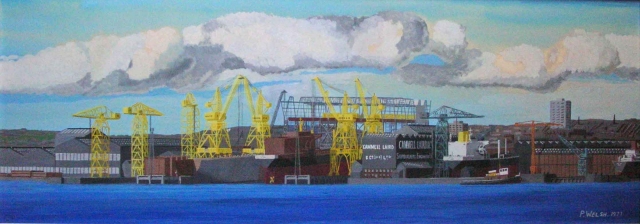Categories
Enquiry
I am to respond to all order enquiries as soon as possible.
C1977 Cammell Laird Shipyard

C1977 Cammell Laird Shipyard
CAMMELL LAIRD SHIPYARD SPRING 1977
This illustration was based on how the shipyard looked during the early part of 1977. This particular year was a very significant one for the Company, since it was to be the last under commercial ownership. On 1st July 1977, like all other shipbuilders nationwide, the yard became a subsidiary of British Shipbuilders Ltd – the nationalised name for UK Shipbuilding.
Turning to the yard scene, perhaps the most obvious change which was taking place within its confines concerned the construction of the large covered shipbuilding hall,which occupied the western area at the head of slipways 2 to 5. The project which had begun some three and a half years earlier, had suffered from various delays not connected with the shipbuilding company itself, but by the appointment of new civil contractors on site in 1975. When originally proposed,the facility was intended to construct large vessels undercover,then gradually extruded out of the building progressively to be followed by a conventional dynamic launch into the River Mersey.The vessel(s) would then be fitted out with minimum time in the basin area of the yard.
The slipways are all occupied with the exception of number one, the vessels under construction represent the second, third and fourth in a series of “Stat 55” tankers building for subsidiaries of Alva Shipping Holdings,part of the Vlasov Group of Companies.
No. 2 slipway is occupied by yard no.1368 “Alvega”,she was nearing the launching stage,which was to take place on March 8th.The next slipway, what in fact used to be numbers 3/4/5 is occupied by Yard no.1369,her launch was not to take place until November,whilst her sister vessel 1370 which is occupying no.6 slipway was almost twelve months away from launch stage.
Turning to the fitting out basin, the engine shop wall or south quay is occupied by yard no.1367,”Algol”,the first of this series of tanker,she was nearing preliminary sea trials and her debut was awaited.
Partly out of view to the right of the picture is yard no. 1365 “Hudson Deep”,she was the third of four “Stat32” tankers ordered by John Hudson Fuel & Shipping Ltd of Brighton,sadly these owners did not take delivery of her or her predecessors,owing to financial problems.
Her predecessors “Hudson Progress” and “Cavalier” were both at this time laid up in Brocklebank dock,Liverpool “mothballed” awaiting an upturn in trade.
The fourth vessel,yard no.1366,was not actually constructed in the original guise for commercial owners,but emerged some five years later as RFA “Bayleaf” and curiously was joined by her older sisters during the early part of the 1980s in the Royal Fleet Auxilliary all having been converted to Fleet Support Tankers.
Copyright: Philip Welsh 1998
